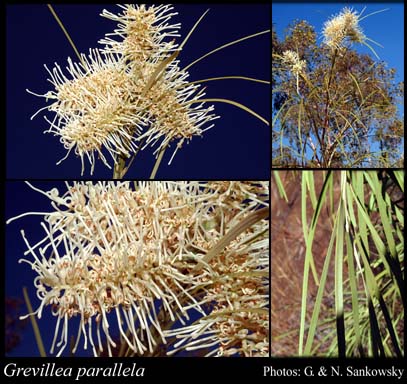- Reference
- Cult.Prot. 121 (1809)
- Conservation Code
- Not threatened
- Naturalised Status
- Native to Western Australia
- Name Status
- Current
Tree, 4-8 m high. Fl. white-cream/yellow-green, May to Jul. Sandy soils. Flats, sandstone rocks.

Scientific Description
Trees, 6.5-10 m high; branchlets glabrous or hairy, not glaucous. Leaves alternate, 150-370 mm long, 2-5 mm wide, hairy or glabrous, on the adaxial or abaxial surface, the hairs straight; lamina flat, once divided, pinnately divided, entire or divided to the midrib; lobes 20-200 mm long, 1-10 mm wide, the margins flat. Inflorescences axillary or terminal, green, white, cream or yellow; pedicels 2-5 mm long. Perianth 8-13 mm long; tepals some joined and some free after flower opens, hairy, simple-hairy; ovary glabrous, stipitate, the stipe 1.5-2.5 mm long; pistil 18-25 mm long, green, white, cream or yellow, pollen presenter oblique, style glabrous. Follicles glabrous, not viscid, dehiscent, 14-29 mm long. Flowers in June, July, August, September or October. Occurs in the Northern (N) Botanical Province(s), in the Northern Kimberley (NK), Victoria Bonaparte (VB), Central Kimberley (CK) or Dampierland (DL) IBRA subregion(s).
Distribution
- IBRA Regions
- Central Kimberley, Dampierland, Northern Kimberley, Victoria Bonaparte.
- IBRA Subregions
- Berkeley, Fitzroy Trough, Hart, Keep, Mitchell, Pentecost.
- Local Government Areas (LGAs)
- Derby-West Kimberley, Halls Creek, Wyndham-East Kimberley.